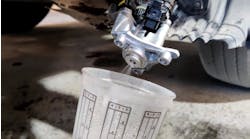When the diesel engine was invented over 100 years ago, it transformed society, allowing the world to revolutionize in a safer, more cost effective, and more efficient way. Though the technology has evolved over time, it is still a literal driving force of industries all around the world. Today, however, this technology requires significant investment in order to keep pace with the changes of the world around it.
For instance, those perhaps most reliant on their engines—the commercial transport sector—are having to increasingly adapt to rising costs, supply chain disruption, and evolving environmental targets. While investing in new engine technology could be the answer to all three by helping to improve efficiency, utilization, and sustainability, a turbulent financial climate often prevents this from happening—even if the alternative is to risk costly repairs. Facing a dilemma between spending money or incurring costs, perhaps the answer lies in another crucial investment: Investing in their current engine’s maintenance and performance.
How to cut costs without cutting corners
Fuel costs represent the biggest single cost factor for fleet businesses outside of their staff, comprising roughly 28% of cost per mile, according to ATRI’s 2023 data. Maintenance and repair costs, meanwhile, are generally much less than this, around 9% cost per mile. However, maintenance budgets can have a disproportionately large impact on fuel and oil costs, due to the influence that maintenance decisions can have on fuel economy.
This impact is best illustrated by focusing on the individual components that sit within the engine, like fuel injectors, for example. A critical and intricate part, injectors work in the heart of the engine and, as a result, are directly exposed to combustion. This direct exposure can lead to deposit build-up in and around the injector nozzle holes, which—when left untreated—risks inefficient combustion, power loss, and increased fuel consumption.
All three of these consequences spell trouble for a business’ bottom line, given the potential load-pulling power lost and amount of fuel wasted over time if no remedial action is taken. Thankfully, the solution is a simple one, and it involves cleaning the fuel injectors: First, by removing these performance-robbing deposits and then by keeping the injectors clean in the longer term.
Read more: Diesel engine oil: Product Spotlight
Best of all, this a process that does not require a new product – vehicle nor part – to be purchased. In fact, it relies on something that every fleet diligently budgets for already: their fuel.
How to navigate supply chain disruption
While the components inside an engine may fall within a fleet’s orbit of control, volatile supply chains perhaps seem the opposite. Whether related to production delays, inventory shortages, route disruption, or capacity constraints, road transport fleets can end up on the wrong end of external events. These are elements even a brand-new fleet of vehicles might not be able solve without the right practices in place.
However, there is one way that fleets can combat these socioeconomic influences and start to put themselves back in the driving seat. By removing the restrictions of unplanned and unnecessary downtime and ensuring their vehicles are always ready for operation, a business can be more agile in the face of these changing conditions.
The easiest and most cost-effective way for a fleet to remain agile? Ensuring they deploy proactive maintenance, so they can afford to be reactive when it comes to an evolving operating environment. For a specific example, consider the exhaust gas recirculation (EGR) system that can be found in most modern vehicles. Designed to recirculate exhaust gas to the intake system, an effective EGR system helps control NOx emissions.
However, if deposits form in the EGR system, they can cause valves to become stuck or block coolers, both of which can lead to reduced vehicle reliability and unplanned downtime. Again, fuel choice can have a big impact on how this scenario plays out. If formulated with combustion improver, fuel can provide greater EGR deposit control, helping to support reliable engine performance so vehicles can spend more time on the road than off schedule.
Shell FuelSave diesel, for example, was formulated to help remove carbon deposits from the injectors and prevent further build-up, which can enable fuel economy up to 3.75% and lower operating costs, according to Shell. It also incudes a corrosion inhibitor to prevent corrosion in critical fuel system parts and the fuel tank.
Partnership is the new leadership
In an industry where tight driving schedules and fuel costs underpin success, investing in advanced fuel technology—and unlocking its maintenance benefits—is an obvious choice. After all, it can help you meet today’s most pressing challenges even if you can’t yet afford to invest in tomorrow’s engine technology. And while even the most basic diesel engine technology today is miles ahead of where it began, the importance of the historical invention remains, with more value than ever lying in the potential partnership between a road transport fleet and industry-leading solution providers.
This article was provided by Shell Commercial Fuels.



